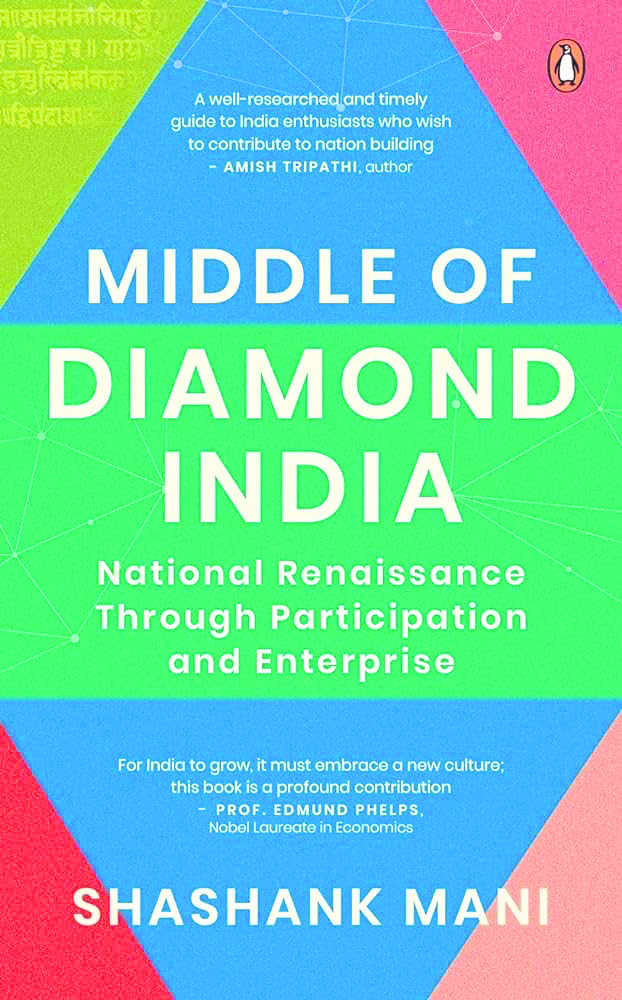
In a world consumed by technology, accompanied by concerns of AI’s potential of displacement of human volition in a not too long a future, books that reiterate the value of human capital are not only refreshing but necessary. Such books give us hope that technology is only an aid, as the author Shashank Mani mentions, but also show that the India of small towns and villages is throbbing with an understanding of what makes for stability and sustainability in the face of uncertainty. We just have to go there and search and we shall find!
With what we know up until now, sustainability, that is getting much attention globally, will have to be the work of humans acting responsibly, including on the deployment of technology. The book addresses this by weaving the threads of Udyamita or entrepreneurship as the vehicle of myriad hues in Tier 2 and 3 districts, the composite home of the population of Middle India. India is a Diamond, the author, Shashank Mani says, with Middle India comprising 800 million, the bottom comprising 400 million, and the top with mostly those residing in the metros comprising 200 million. The worth of this formulation todayis immense since we have been operating on the 2002 framework of Bottom of the Pyramid that showed two Indias — one small rich one and the rest poor.
Whereas India has evolved to show much complexity and nuance in its navigation of culture and asymmetry in development. Middle India represents this evolution of small and medium enterprises that fires the engine of growth by job creation. Shashank outlines thisusinghis engaging storytellingof the pioneering 18 year old annual Jagriti Yatra for Udyamita and its purpose of inspiring the young to become job creators rather than job seekers.
Bringing in Indic wisdom embodied in Sanatana Dharma and Vedanta and spread by recent travellers like Swami Vivekananda, Shashank Mani’s message is simple: we have to move away from the linear models of growth that we have adopted from the west favoringcommodityextractionleading to destruction of the planet to offering to the world our civilisational values of integrative growth that combines all forms of capital in a judicious balance — culture, social, ecological, economics, natural, and more. This integration is brought to life in the experience of 500 young people over the intensely curated two weeks of Udyamita inspiration and learningon the Yatra and how Yatris absorb the breathtakingdiversity of people and development action they see and experience on and off the train.
Udyamita, as Shashank describes it, is not the entrepreneurship one has learnt from books and understanding of countries like the US. It is unique to India, particularly Middle India. It is driven by a sense of serviceand collaboration with family and community and self-growth incorporates that sense. The preservation of culture and traditionsis intrinsic to this sense. Women of Middle India, in particular, display the integration in its fullest sense since they not only engage in the workforce but also in caring — for family, for maintaining their culture and traditions, and for the extended community so that society as a whole benefits from their productive participations. Shashank calls women“balance sheet builders” and men as focused on profit and loss. An apt characterisation, indeed. Women-led Udyamita he sees as having the maximum societal benefits.
We have just celebrated International Women’s Day so the balance sheet building capabilities of women require recognition not as just binaries of paid and unpaid work as their workforce participation is characterised in economics but as Udyamita for building societies. The two chapters on Culture and Women show the big canvas of thought and action based on our values and practices that are in evidence in Middle India that guides Udyamita — the Indian way.
Shashank delights with vignettes in his own personal and professional journey of navigating culture in a metro city, overseas and his background in Gorakhpur in Middle India. As India’s growth story gains more traction, it is critical for young leaders to look similarly at who they are and what they are capable of because there is probably more motivation and capability of an Indian kindthat is yet to be discovered. Beneath the surface of entrepreneurship, beyond standard business school and investor beliefs, culture and context shape and nurture Udyamita. It is only by such understanding, articulated with depth and finesse in the book, that we can create jobs, run sustainable enterprises, ensure balance of ecology and economics and truly build India.
The author is the Social Entrepreneur and Founder, Udyogini.